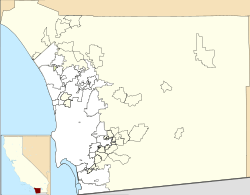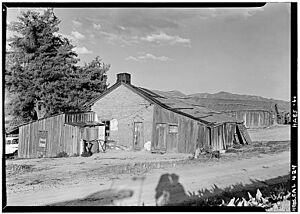Warner's Ranch facts for kids
|
Warner's Ranch
|
|
 |
|
| Nearest city | Warner Springs, California |
|---|---|
| Built | 1849 |
| NRHP reference No. | 66000228 |
Quick facts for kids Significant dates |
|
| Added to NRHP | October 15, 1966 |
| Designated NHL | January 20, 1961 |
Warner's Ranch, found near Warner Springs, California, was a very important stop for many travelers. From 1849 to 1861, it served as a resting place on the Southern Emigrant Trail. This trail included the Gila River Trail and the famous Butterfield Overland Mail stagecoach route. The ranch was also a pioneering cattle ranch.
The property is about 221-acre (0.89 km2) in size. It has two original adobe buildings from 1849 and 1857. In 1939, it was named a California Historical Landmark. Later, in 1961, it became a National Historic Landmark. Many travelers stayed at the first ranch house built in 1849. The ranch is located about 4 miles (6.4 km) south of Warner Springs.
Contents
History of Warner's Ranch
Early Days and Native Americans
This area was home to the Cupeño American Indians for a long time. They first met Europeans when Spanish missionaries arrived. The Cupeño were forced into the mission system. Over time, they lost control of their land. However, they continued to live and work in the area.
John Warner and the Ranch
In 1830, an American named John Trumbull Warner traveled from Connecticut to California. He passed through this valley. He worked as a fur trader and merchant in Los Angeles. By 1844, he became a Mexican citizen and changed his name to Juan Jose Warner. He received a large piece of land called the Rancho San Jose del Valle. Warner then started a successful cattle ranch there.
A Stop for Travelers
On December 2, 1846, Stephen Watts Kearney and his soldiers reached the ranch. They were on their way to the Battle of San Pasqual. Later, the Mormon Battalion followed. They were creating the route for Cooke's Wagon Road.
From 1849 to 1851, Warner used part of his ranch to help travelers. These travelers were on the Gila River Emigrant Trail. This trail was part of the Southern Emigrant Trail. Warner opened the only trading post between New Mexico and Los Angeles. It was on a wagon road made after the Mexican–American War. Thousands of people began traveling to California. This trail was later used by the Butterfield Overland Mail stagecoach line from 1857 to 1861.
Challenges and Changes
When California became part of the United States, new taxes were put on the Cupeño people. Many of them worked at Warner's Ranch. The ranch had a difficult reputation for how it treated Native Americans. In 1851, there was an uprising by the local Cupeño tribe. It was led by Antonio Garra. Warner was attacked at his ranch. He sent his family to Los Angeles. Some ranch buildings were burned. Warner kept running the ranch until someone else claimed his land.
Warner's Ranch was a stop on the San Antonio–San Diego Mail Line in 1857. It was also a stop for the Butterfield Overland Mail stagecoach line from 1858 to 1860. It was connected to San Diego by a road through Santa Isabel. Travelers rested here after their long trip through the desert.
During the American Civil War, Union soldiers set up Camp Wright at Warner's Ranch. This happened on October 18, 1861. The camp was meant to protect California from attacks along the travel route. Because of strong winds, the camp was moved. Major Edwin Augustus Rigg moved it on November 23, 1861. It went to Oak Grove Butterfield Stage Station, about 20 miles (32 km) north.
Later Ownership and Relocation
The ranch was owned by several different people. In 1880, John G. Downey, a former governor of California, became the sole owner. In 1892, he started legal actions to remove the Cupeño people. The Cupeño argued that they had rights to the land. They used Mexican and United States laws to support their claim. However, they lost their case in the U.S. Supreme Court in 1901. The court said they were right about their land rights. But, they had waited too long to make their claim. Many people felt sympathy for the Cupeño. They tried to buy their own land but could not raise enough money. The Cupeño tribe was moved to the Pala Indian Reservation on May 12, 1903.
The hot springs at the ranch were first advertised in 1894. A resort called Warner Hot Springs slowly grew there. It became very popular in the 1950s.
The ranch house was named a National Historic Landmark in 1961. The 221-acre (0.89 km2) property now has the restored 1849 adobe ranch house. It also has the restored 1857 Carillo Adobe and barn. This barn was the original Butterfield Stage Station and Trading Post.
Warner's Ranch Today
The historic part of the ranch includes an adobe ranch house and a barn. The Ranch House has been fixed up. It is open to the public on weekends from 12 PM to 4 PM. You can also visit by making an appointment.
See also
 In Spanish: Rancho de Warner para niños
In Spanish: Rancho de Warner para niños






